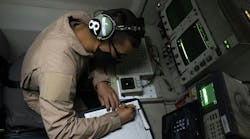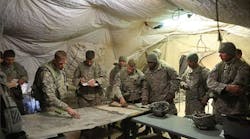By Courtney E. Howard
SAN DIEGO–U.S. Navy researchers are looking into issues ranging from nonlinear dynamics to sensors, MEMS (microelectromechanical systems), and cold fusion to bring about quantum improvements in current systems, including computers, communications, and sensors.
“Can we mimic the brain with analog neural net architectures based on arrays of nonlinear coupled oscillators,” said Dr. Frank Gordon, head of the Research and Applied Sciences Department at the U.S. Navy’s Space and Naval Warfare Systems Command (SPAWAR) in San Diego in a keynote address at the Military & Aerospace Electronics Forum. This research is likely to bring about speech, voice, and vision recognition breakthroughs, as well as potential autonomy in unmanned vehicles.
“Things we as humans do routinely are difficult for computers to do,” Gordon told attendees. He raised eyebrows with evidence of research in the area of leech computers and path finding. SPAWAR scientists take neurons out of leeches, put them on a silicon substrate, and inject a solution to keep the neurons alive; they start to communicate and process things collectively, he describes. Hybrid living/silicon systems are just one area of study for SPAWAR researchers, with the goal of improving U.S. national security.
“We have one of the strongest missions you can have, and that’s C4ISR [command, control, communications, intelligence, and reconnaissance],” Gordon says. SPAWAR Systems Center (SSC) Pacific is the U.S. Department of Defense center of excellence and the nation’s only full-spectrum C4ISR Lab, he adds. The total SPAWAR presence is roughly 7,500 people–of which 4,200 are based at SSC Pacific–and $9.869 billion.
During his technology talk, Gordon explained that SSC Pacific researchers are work on more than 800 projects at any given time. His researchers have conducted 20 years of SSC Pacific Low-Energy Nuclear Reaction (LENR) research.
SPAWAR has “survived 20 years in this controversial field. The next step is conducting experiments and understanding the underlying physics,” Gordon says.
Of the organization’s $2.5 billion budget, roughly 65 percent “goes out to industry.” Gordon and his colleagues encourage industry to reach out to SPAWAR, and specifically SSC Pacific, as the researchers are “always scanning the horizon for new ideas.”


